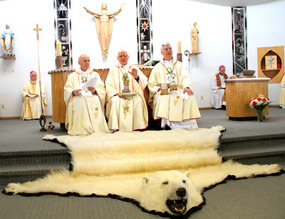Many times when Catholics think of inculturation they mis-identify the term by saying that the Church just needs to lighten up its rule and fit to the local culture. Others will locate the philosophical and missionary effort inculturation in the liturgical sphere. Inculturation matters are a very contentious matter that gets people in crosshairs. Adapting or in some way making changes to a system of living so that you can “fit in” is an external fact and is not the method the Catholic Church uses to bring Lord’s Good News to other peoples, that is, those who outside the European and North American context. The Catholic Church tends to focus on the interior life of the person; externals are secondary and may change in time.
There is, however, a more precise way of understanding inculturation deals with adaption in saying that it is “the incarnation of the Gospel in autonomous cultures and at the same time the introduction of these cultures into the life of the church” (John Paul II’s 1985 encyclical Slavorum Apostoli, or his address to the Pontifical Council for Culture plenary assembly on Jan. 17, 1987). It is also understood that inculturation is, as John Paul II said in his 1990 encyclical Redemptoris Missio, “an intimate transformation of the authentic cultural values by their integration into Christianity and the implantation of Christianity into different human cultures.”
As Redemptoris Missio said, “By inculturation, the church makes the Gospel incarnate in different cultures and at the same time introduces peoples, together with their cultures, into her own community” (52). And yet the Church speaks of a interpenetration of the Gospel into a given, that is, a particular socio-cultural context which “gives inner fruitfulness to the spiritual qualities and gifts proper to each people …, strengthens these qualities, perfects them and restores them in Christ” (Gaudium et spes, 58). More on this issue here.
This is a long way to introduce the sticky issue of Indian Catholics retaining their customs of endogamy and not truly inculturating the Gospel. Judge for yourself: do the adherents to Knanaya customs cause a philosophical and theological problem here is that if we use the definitions noted above, or are we being “too Western” in wanting others to conform to a radical way of thinking which may weaken a culture? How would Christ judge the situation? Who bears the standard? How are the demands of the gospel really lived in this Christian caste? Who has ultimate authority, the Syro-Malabar Catholic Church, the Holy See, or the persons involved? Can endogamy be tolerated for a greater good?
The story of alleged discrimination among the Syro-Malabars can be read here.

